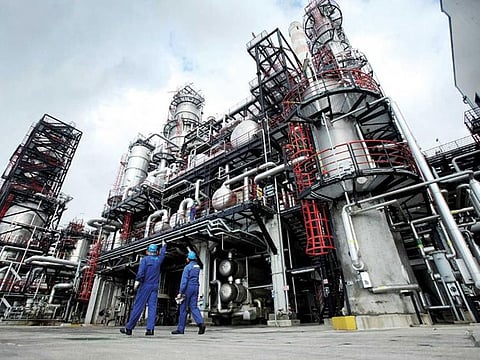Oil falls in choppy trade on mixed China COVID signals
Chinese health officials reiterated their commitment to strict COVID containment

Highlights
- Brent crude futures fell 65 cents to settle at $97.92 a barrel.
- Earlier in the session, they rose to a high of $99.56 a barrel, the highest since Aug. 31.
New York: Oil prices fell on Monday, paring gains after rising to more than two-month highs, on mixed signals over China, the world's top crude importer, potentially relaxing its strict COVID-19 restrictions.
Brent crude futures fell 65 cents to settle at $97.92 a barrel. Earlier in the session, they rose to a session high of $99.56 a barrel, the highest since Aug. 31.
US West Texas Intermediate crude dropped 82 cents to settle at $91.79. It earlier rose 74 cents to a session high of $93.74 a barrel, the highest since Aug. 30.
No Zero COVID exit timeline
Prices climbed during the session on news that Chinese leaders are considering reopening the economy from strict COVID-19 restrictions but are proceeding slowly and have set no timeline, the Wall Street Journal reported, citing sources.
"The market seems to be thinking that if China opens the economy, that would tighten supply significantly and put further upward pressure on prices," said Phil Flynn, an analyst at Price Futures Group.
However, weighing on futures, Chinese health officials at the weekend reiterated their commitment to strict COVID containment measures.
Meanwhile, China's imports and exports contracted unexpectedly in October, but its crude oil imports rebounded to the highest level since May.
Adding some price support, the U.S. dollar sank against the euro on Monday and sterling was supported by risk-on sentiment and a rally in European stock markets. A weakening dollar makes greenback-denominated oil less expensive for other currency holders, helping push prices higher.
Tighter supplies
Oil prices have also been underpinned by expectations of tighter supplies when the European Union's embargo on Russia's seaborne crude exports starts on Dec. 5, even though refineries worldwide are ramping up output.
"For a lot of folks, it looks like there is going to be a scramble for barrels come December, in particular in the euro zone," said Bob Yawger, director of energy futures at Mizuho in New York. US oil refiners this quarter will run their plants at breakneck rates, near or above 90% of capacity. China's largest private refiner Zhejiang Petroleum and Chemical Co (ZPC), meanwhile, is raising diesel output.
Kuwait Integrated Petroleum Industries Co (KIPIC) said on Sunday the first phase of its Al Zour refinery had started commercial operations, the KUNA state news agency reported.
Rebound in China crude imports less impressive
China's imports of crude oil rebounded in October, but the details aren't as strong as the headline number suggests.
The world's largest crude buyer imported 10.16 million barrels per day (bpd) in October, the highest since May and a 14% leap from the same month in 2021, according to data released on Monday by China customs.
There were several factors driving the increase in October, but a strong demand-led recovery is unlikely to be one of them. Rather, it was a combination of crude being imported to build operating inventories for two new refinery units, a lower price versus prior months, more import quotas for independent refiners and an ongoing boost to exports of refined fuels.
PetroChina started trial operations at a 200,000 bpd crude unit at its new refinery in Guangdong, while Shendong Petrochemical is also starting operations at its new 320,000 bpd plant in Jiangsu province.
Refinery units typically need about three weeks of operating inventories, suggesting the two new plants would require almost 11 million barrels of crude to fully commence operations.
Algeria's Sonatrach, Eni start production
Cairo: Sonatrach and Italy's Eni have started production at the HDLE/HDLS oil field in the Berkine Basin at 10,000 barrels of oil equivalent per day, the Algerian company said in a statement on Monday. The oil field is expected to increase output to 17,000 barrels of oil equivalent per day with new drilling in 2023, the statement added.
Sign up for the Daily Briefing
Get the latest news and updates straight to your inbox



